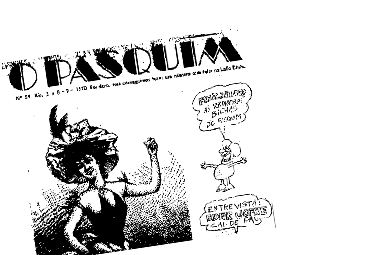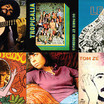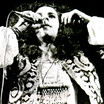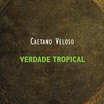Ruídos pulsativos

Marginália
Underground, ‘marginal’, ‘nanica’ (small, or dwarf) and alternative were some of the 1970s terms used to describe a series of publications which circulated during the military dictatorship. Their link with the concept of ‘marginália’ came from their clandestine and iconoclastic operations and from texts which broke with the official journalistic standards of the time. Newspapers, magazines, almanacs and supplements were put together and launched with the aim of creating new avenues for the circulation of information and ideas.
The founding member of the alternative press was, without doubt, the weekly Rio newspaper O Pasquim (The Satirical Leaflet). From the moment of its launch in 1969, this weekly newspaper became obligatory reading for an influential portion of the population. News and theoretical essays were printed side-by-side with humorous articles and tidbits of gossip from Rio’s cultural circles. O Pasquim was set up by an eclectic group of journalists, satirists and cartoonists gathered together from various Rio newsrooms of the 1960s: Tarso de Castro (founder of the paper), Millôr Fernandes, Paulo Francis, Jaguar, Henfil, Fortuna, Ziraldo, Sérgio Cabral and Luís Carlos Maciel. Because of the large number of key figures who were in exile, several of the columns were written by “international correspondents”, notably Chico Buarque, Caetano Veloso, Ferreira Gullar and Glauber Rocha. The success of Brazil’s first alternative publications set off a boom which was to continue throughout the 70s.
The content of the most important alternative newspapers of the period falls into two main categories: firstly, the theme of counterculture, with newspapers such as Flor do Mal (Flower of Evil), Presença (Presence) and Verbo Encantado (Enchanted Word) and magazines such as Pólem (Pollen), Bondinho (Little Tram), Código (Code), Rolling Stone and JA (Jornal de Amenidades – Newpaper of Conveniences); and secondly, the theme of struggle against the military dictatorship, with the focus on political debate and the nation’s economic problems, represented by papers such as Opinião (Opinion) and Movimento (Movement).
Those newspapers in the marginália category originate, at least in part, in the columns written by Luis Carlos Maciel for Pasquim. Under the heading ‘Underground’, Maciel wrote a series of articles about such subjects as pyschoanalysis, oriental philosophy, hallucinogenic drugs, life on a commune and so on. Soon after he left in 1972, he teamed up with Rogério Duarte, Torquato Mendonça and Tite de Lemos to launch Flor do Mal, which turned out to be short-lived, as was the case with most of the launches of the time.
The ultimate example of a Brazilian underground publication is Navilouca (Crazy Ship/Ship of Fools), an almanac of which only one edition was ever published. Commissioned, organized and edited by Torquato Neto and Waly Salomão, it was nearly two years in preparation and was published in 1973, after the death of Torquato. With striking graphics and stylish lay-out, Navilouca was a compendium of the best-known names in marginália, with texts and visuals that were ground-breaking even for that time. Besides the editors themselves, the contributors included Hélio Oiticica, Lygia Clark, the Campos brothers, Caetano Veloso, Ivan Cardoso, Luciano Figueiredo, Oscar Ramos, Duda Machado and Rogério Duarte, among others. It is also worth remembering that throughout 1971-72, Torquato Neto wrote his column “Geléia Geral” (“General Jam’”) in the Rio newspaper Última Hora. While this was not an underground newspaper (rather, a popular, down-market daily), Torquato’s texts mixed poetry, information and cultural hints, and were read by the same young audience that read the alternative press.
Other magazines in this universe of counterculture and vanguard information were Pólem (Pollen), by Duda Machado, and two magazines edited by Antonio Risério in Bahia – Código and Muda (with a double meaning – ‘Change’, or a ‘Cutting’ from a plant). Besides these, the São Paulo magazine Bondinho and the Brazilian version of Rolling Stone, also edited by Luis Carlos Maciel, were directed at a young public, fans of rock-and-roll and the MPB stars who had identified themselves with countercultural ideas.
There were many other publications that have not been cited here, yet, despite their proliferation, few were ever to achieve anything like the success that O Pasquim enjoyed in its first few years. By the end of the 70s, the only newspapers still left in the circuit of Brazil’s alternative press were the political papers.






















